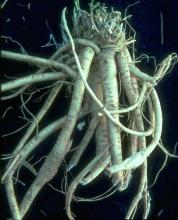

Astragalus
Astragalus membranaceus
Astragalus is a member of the Pea and Bean family, the Leguminosae. It is a sturdy plant, requiring only marginal fertility and good drainage for its taproot ~ although a bit of good compost will increase root size considerably. It takes between 5 and 7 years for a plant to come to maturity; to ensure abundant harvests, it is a good idea to side-dress at least once a year.
Elemental associations: Earth
Phytochemistry: Steroidal saponins, selenium, fatty acids, mucilage (Herotani, He, Virupaksha)
Actions: Immune tonic, highly nutritive, diuretic, expectorant
Specific systems: Lungs, immune system
This excellent herb has come to us from the Materia Medica of the Chinese, where it has long had a reputation as an excellent, often-prescribed tonic. Its diuretic and expectorating power make it especially effective in the gentle elimination of the by-products of long-term illness; couple this with its marked immune-enhancing power, and you have an excellent remedy for convalescence.
Many people who use Echinacea should turn to Astragalus instead, as it has no long-term dangers and provides true prophylactic effect for the common cold and flu, unlike Echinacea that should only be used at the first signs of an infection.
Added to broths with Ginseng and Reishi, Astragalus can help older people regain vitality and resistance, and has been known to help in cases of anemia. It is speculated that part of this root’s activity resides in gentle stimulation of red and white blood cells at the bone marrow level. For this reason, it is usually included in protocols for cancer treatment, whether alongside conventional medicine (to help prevent anemia and fatigue), or with other herbals.
Indications: Winter health, recovery from illness, anemia and debility in the elderly, prevention of respiratory infection, cancer
Contraindications: None really; avoid use during the acute phase of an infection
Preparation/Dosage: Decoction can be prepared from the long ‘tongue-depressor’ slices of the root. Look for a good buttery-yellow color and a sweet flavor. Simmer 3-4 slices, shredded, in a quart of water for 45 minutes to 2 hours. The tincture of the fresh roots is also used, at 50% alcohol, 1:3. Take ¼ teaspoon 2-3 times daily.
